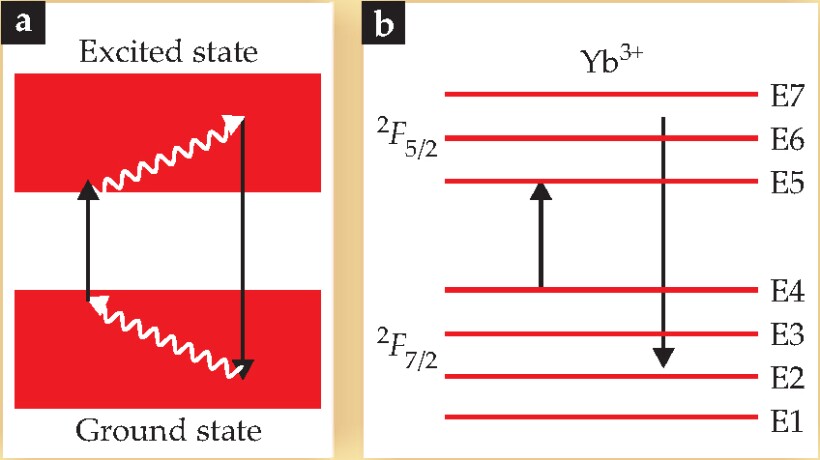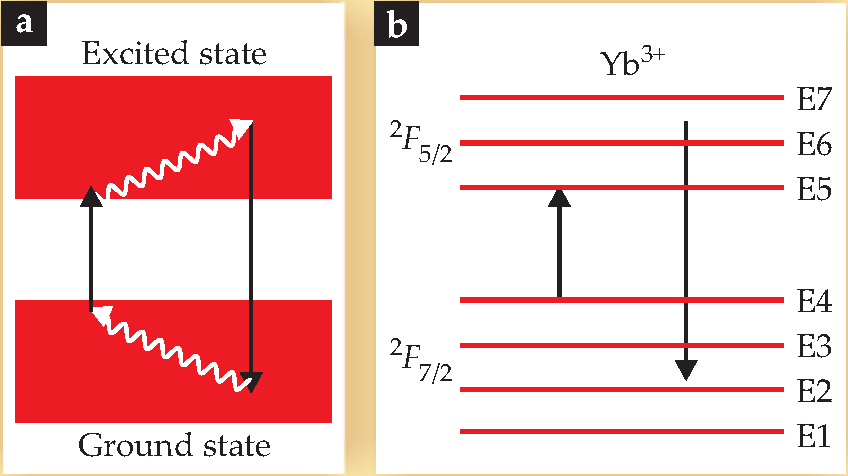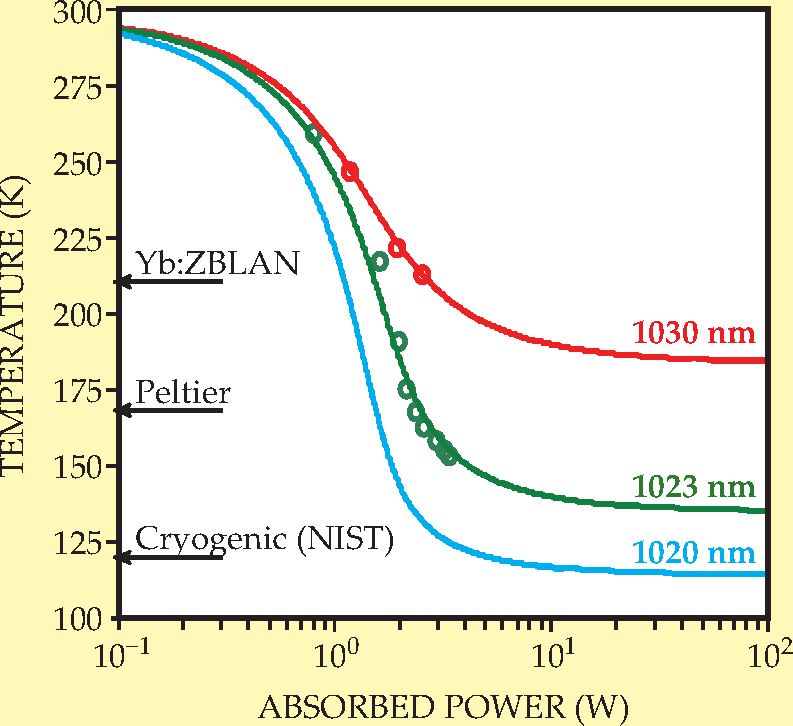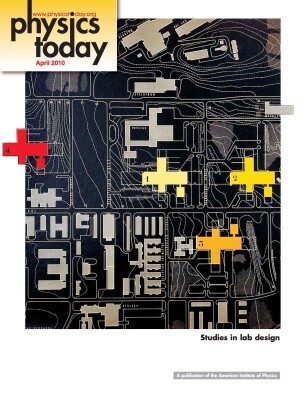Optical refrigeration sets solid-state cooling record
DOI: 10.1063/1.3397031
Radiation , along with conduction and convection, is a form of heat transfer. But in some circumstances, radiation can also induce cooling: Laser light can cool dilute gases of atoms whose thermal energy takes the form of relative translational motion. It can also cool some specially prepared solids whose thermal energy is contained in lattice vibrations.
The basic scheme for optical refrigeration of a solid is shown in figure 1(a). A laser excites a transition from an upper level of one state to a lower level of another, and a higher-energy photon is emitted, with phonons making up the energy difference. If the pump light is generated by a semiconductor diode laser, the cooling system as a whole has no moving parts or fluids—a particular advantage for spaceborne applications.

Figure 1. Optical refrigeration shown schematically. (a) In the general case, the solid sample absorbs a laser photon (black upward arrow) and emits a photon of higher energy (black downward arrow), with phonons (white arrows) making up the energy difference. (b) So far, optical refrigeration has been demonstrated only in solids doped with rare-earth elements such as ytterbium, whose two lowest-energy states are split by the surrounding host atoms into seven sublevels. The intrastate splitting is exaggerated for effect: In Yb-doped yttrium lithium fluoride, the energy difference between levels E4 and E5 is more than 70 times the splitting between E5 and E6.

So far, every demonstration of optical refrigeration has used a transparent material doped with a rare-earth element—usually ytterbium, but some studies have used thulium and erbium. The surrounding atoms split the dopant ions’ two lowest-energy states into several sublevels, as shown in figure
Now researchers led by Mansoor Sheik-Bahae of the University of New Mexico in Albuquerque and Mauro Tonelli of the University of Pisa in Italy have set an optical refrigeration temperature record. 1 They’ve cooled a solid sample of Yb-doped yttrium lithium fluoride (Yb:YLF) from room temperature to 155 K—about 10 degrees colder than can be achieved by standard thermoelectric Peltier coolers, previously the best-performing all-solid-state cooling system.
A balancing act
Each optical absorption-emission cycle extracts only a tiny amount of energy from the sample—at most a few percent of the absorbed photon energy. So for cooling to succeed, several processes that heat the sample need to be kept to a minimum. First, the transition from excited state to ground state can release phonons rather than photons; just one such nonradiative conversion can undo the cooling of many emitted photons. Fortunately, nonradiative conversion tends to be limited in rare-earth-doped materials, since the key optical transitions occur in the 4f electron shell, which is shielded from the rest of the solid by the 5s and 6s shells. Second, photons can be absorbed by impurities other than the dopant atoms. The magnitude of such parasitic absorption depends, of course, on the sample’s purity. Finally, heat is transferred from the environment to the sample at a rate determined by the apparatus design.
At the same time, the rate of absorption-emission cycling must be maximized. That rate depends on the laser power, the dopant concentration, the absorptivity of the dopant atoms at the laser wavelength, and the population of dopant atoms in the upper ground-state levels. As the sample cools, the thermal population of those levels decreases, and cooling slows and eventually stops.
The previous optical cooling record, 208 K, was set in 2005 by Richard Epstein and colleagues at Los Alamos National Laboratory. 2 Those researchers used Yb-doped ZBLAN (a glass composed of fluorides of zirconium, barium, lanthanum, aluminum, and sodium), the material in which optical cooling had first been observed. 3 ZBLAN’s appeal was that it was used in optical fibers, so methods had been developed for synthesizing it to high purity. But its cooling potential is inherently limited. The Yb3+ dopant takes the place of La3+ ions, so the dopant concentration cannot exceed the amount of La3+ in the glass. And the glass’s amorphous structure broadens the Yb3+ energy levels, so the peak absorption is relatively weak.
Crystal clear
Because Yb:YLF is a crystal, its Yb3+ absorption peaks are sharp. And because Yb3+ replaces Y3+, which makes up more than half of the material’s mass, much higher dopant concentrations are allowed. But methods for synthesizing Yb:YLF to high purity are not as well developed as they are for Yb:ZBLAN. As Sheik-Bahae explains, apart from the telecom industry, “Nobody else is as interested in that much purity as we are.”
In 2007 the Pisa team observed slight cooling in Yb:YLF. The New Mexico researchers—primarily Sheik-Bahae’s student Denis Seletskiy—then worked to optimize the conditions for cooling YLF doped with 5% Yb. They enhanced their laser power using an optical cavity. They enclosed their sample in a copper shield to minimize the blackbody radiation absorbed from the environment. And they tuned their high-power laser’s wavelength to 1023 nm—as close to the E4-E5 transition’s 1020-nm absorption peak as the laser would allow. The temperatures they achieved, monitored by a noncontact method based on fluorescence lineshapes, are shown in figure 2.

Figure 2. Temperatures achieved (circles) in optical refrigeration of a sample of ytterbium-doped yttrium lithium fluoride, along with model fits (solid lines). Increasing the rate of cooling—by increasing the laser power or bringing the laser wavelength closer to the 1020-nm absorption resonance—decreases the steady-state temperature. The previous optical cooling temperature record (achieved in Yb-doped ZBLAN), the temperature attainable by a solid-state Peltier cooler, and NIST’s definition of a cryogenic temperature are shown for comparison.
(Adapted from ref. 1.)

The researchers are working on developing a laser that can produce enough power at 1020 nm to excite the E4-E5 transition on resonance. And they think that new crystal-growing processes could produce a Yb:YLF sample that is eight times as pure. Taken together, those improvements could allow cooling to 77 K, the boiling point of liquid nitrogen.
They’ve also succeeded in refrigerating a semiconductor by joining it to the Yb:YLF by a thermal link. What they’d really like to do, though, is to cool the semiconductor directly. In that case, the ground and excited states in figure 1(a) would be the valence and conduction bands. But despite more than a decade of theoretical and experimental research by several groups, net laser cooling of a semiconductor has yet to be observed.
References
1. D. V. Seletskiy, et al. Nat. Photonics 4, 161 (2010). https://doi.org/10.1038/nphoton.2009.269
2. J. Thiede, et al. Appl. Phys. Lett. 86, 154107 (2005). https://doi.org/10.1063/1.1900951
3. R. I. Epstein, et al. Nature 377, 500 (1995). https://doi.org/10.1038/377500a0
